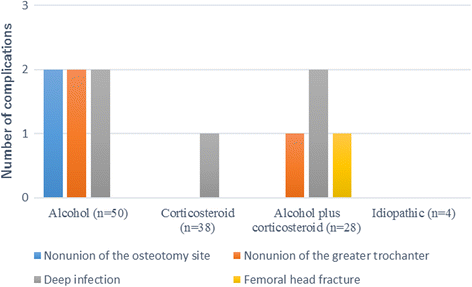Risk factor analysis for postoperative complications requiring revision surgery after transtrochanteric rotational osteotomy for osteonecrosis of the femoral head
- PMID: 29316952
- PMCID: PMC5761186
- DOI: 10.1186/s13018-018-0714-4
Risk factor analysis for postoperative complications requiring revision surgery after transtrochanteric rotational osteotomy for osteonecrosis of the femoral head
Abstract
Background: This study investigated the risk factors for postoperative complications requiring revision surgery within 3 years after transtrochanteric rotational osteotomy (TRO) for osteonecrosis of the femoral head (ONFH).
Methods: We reviewed 127 patients (147 hips) who underwent TRO (anterior or posterior rotational osteotomy) for ONFH between January 2002 and December 2014. Two patients were lost to follow-up, and five patients with progression of femoral head collapse requiring a salvage procedure such as total hip arthroplasty within 3 years after TRO were excluded. The better hip in patients treated bilaterally was also excluded (n = 20) to avoid duplication of patient demographics, leaving 120 hips (120 patients) for the analysis. We reviewed the medical records of each patient to screen for postoperative complications that required revision surgery within 3 years after surgery, recording the patient's age, sex, body mass index, surgical side, condition of the contralateral hip, previous alcohol intake, previous alcohol abuse, previous corticosteroid use, perioperative corticosteroid use, smoking status, preoperative stage and type of ONFH, preoperative activity level, and preoperative and final follow-up Japanese Orthopaedic Association scores. Differences between cases with and without complications were analyzed.
Results: Eleven (9.2%) cases showed postoperative complications that required revision surgery. The most common complication was deep infection (n = 5), followed by nonunion of the greater trochanter (n = 3), nonunion of the intertrochanteric osteotomy site (n = 2), and femoral head fracture (n = 1). The multivariate analysis showed an independent association between previous alcohol abuse and postoperative complications (odds ratio, 13.5).
Conclusion: A correlation might exist between alcohol abuse and complications following a TRO procedure.
Keywords: Alcohol abuse; Corticosteroid; Osteonecrosis of the femoral head; Transtrochanteric rotational osteotomy.
Conflict of interest statement
Ethics approval and consent to participate
This retrospective study was approved by Kyushu University institutional review board for clinical research (NO.27-412) and was performed in accordance with the ethical standards laid down in the 1964 Helsinki Declaration and its later amendments or with comparable ethical standards. We had all the necessary consent from the patients involved in the study, including consent to participate in the study where appropriate.
Consent for publication
Not applicable.
Competing interests
The authors declare that they have no competing interests.
Publisher’s Note
Springer Nature remains neutral with regard to jurisdictional claims in published maps and institutional affiliations.
Figures

References
-
- Lieberman JR, Berry DJ, Mont MA, Aaron RK, Callaghan JJ, Rajadhyaksha AD, et al. Osteonecrosis of the hip: management in the 21st century. Instr Course Lect. 2003;52:337–355. - PubMed
-
- Sakaguchi M, Tanaka T, Fukushima W, Kubo T, Hirota Y. Idiopathic ONF Multicenter Case-Control Study Group: impact of oral corticosteroid use for idiopathic osteonecrosis of the femoral head: a nationwide multicenter case-control study in Japan. J Orthop Sci. 2010;15:185–191. doi: 10.1007/s00776-009-1439-3. - DOI - PubMed
MeSH terms
Substances
Grants and funding
LinkOut - more resources
Full Text Sources
Other Literature Sources
Medical

